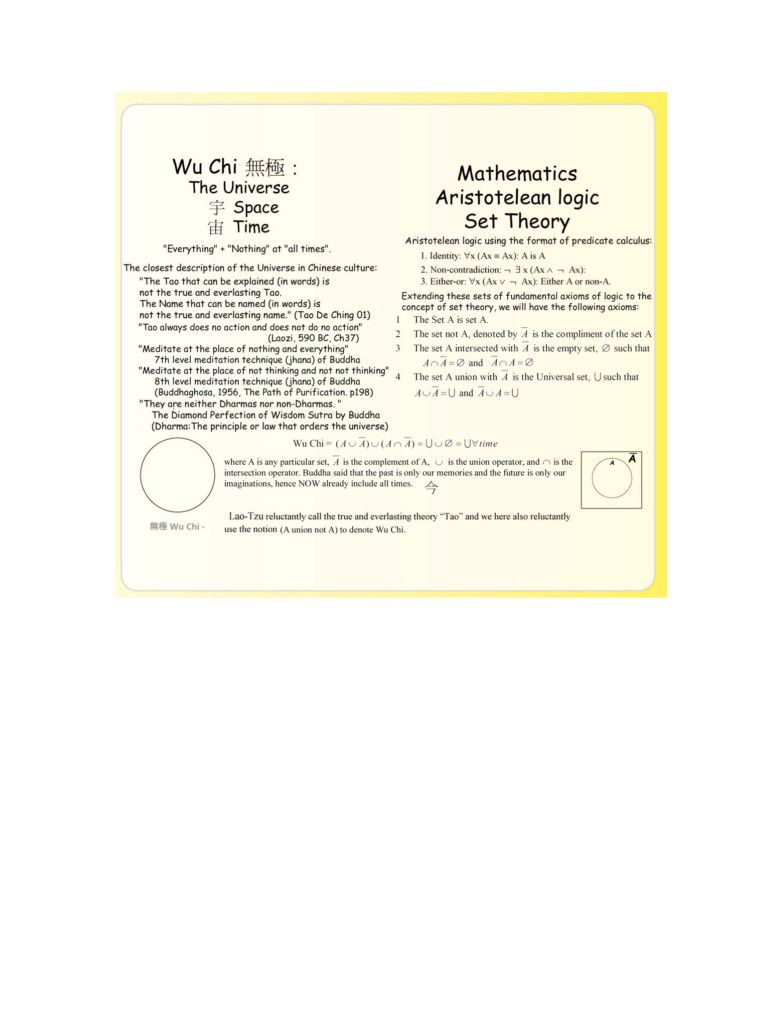The System and Control Theory in the
Vipassana Meditation of the Noble Eightfold Path
as taught by Buddha
-understanding meditation with
the Taichi Yin-Yang system in modern terminologies
E C Yan HUANG 黃炎(筆名)
Ancient Balance Medicine Education Ctr,
_____________Causeway Bay, HK,_____________
Hong Kong. www.EC-Balance.org/blog ;
Prof. Jotin KHISTY
Illinois Institute of Technology, Department of Civil and Architectural Engineering,
3201 S. Dearborn Street, Chicago, IL 60616. khisty@iit.edu
Timothy A GOLDEN
Ancient Balance Medicine Research Institute
ABSTRACT
The theory in the Vipassana Noble Eightfold meditation technique of Buddha is believed
to be the Theory of Everything. However, Chinese believed that the Taichi Yin-Yang
theory is the Theory of the Universe. Albert Einstein and Richard Feynman believed in
the unity of all the equations and theories of physics to explain the nature. Could they be
the different truth of the universe? Or they are all the truth of the universe but only
illustrated in different terminologies? It is believed that the latter one is the case. The
links between these theories are illustrated in this paper using modern system and control
theories.
The evolution of science gave birth to our modern materialistic world. Does this
materialism contradict with our spirituality? It is believed that both of them follow the
Theory of Everything. All the contradictions arise only because of human beings, who
tried to control and manipulate the universe to suit their frame of reference involving
cravings, aversions and ignorance. The practice of Vipassana meditation allows us to
realize the union of materialism and spirituality, because Vipassana helps us to acquire
the ultimate wisdom, to be the master of our own mind, and to be able to make decisions
base not on emotions but on compassion.
Buddha explained the theory of our universe but said that the ultimate truth cannot be
1
The System Theory in the Vipassana Meditation of Buddha
explained in the words and concepts that we use to communicate. Our common senses are
based on pattern differentiation. Our communications are based on languages. And the
fundamental of all languages are mathematical logic, set theory, and Taichi Yin-Yang
system theory, which all are again based on differentiation. Buddha said that the ultimate
truth is without differentiation, which is beyond our common senses and our
communication abilities. However, Buddha taught a method for everyone of us to
experience the ultimate truth ourselves. The beauty of this method is that it is simple,
practical and realistic, involving no sectarianism, no imagination and no super-natural
power. The method is similar to a virus cleaning program that will eliminates all the
impurities within our mind, allowing us to experience the ultimate truth. Even though the
ultimate truth cannot be explained in words, the Vipassana method itself is within our
basic concepts and hence can be explained in terms of system and control theories.
The Taichi, boundary, of this system is the "purification of my mind". According to the
Taichi Yin-Yang theory, the Yin-Yang combo will be formed in different parts of the
system namely the internal part, and the superficial part which acts as the interface
between the internal and the external of the system. Research reveals that the internal Yin
component of Vipassana method is equanimity, the balance of the mind, and the Yang
component is our awareness. The superficial Yin component is wisdom and the Yang
component is compassion. Our goal of regulation is to keep both parts of this system
working within the balanced range of the Cold-Hot and Deficiency-Excess spectrum.
The preparation stage of Vipassana meditation is Anapana meditation, the concentration
of the mind through the observation of the breath. Research shows that the technique
requires the observer to fix the frame of reference on the entrance of the nose. Then
observe the flow of air during breathing in and breathing out. However, only the polarity
of the first derivative of the flow of air at this moment is observed. That is, whether the
breath is coming in or going out at this moment. The value of the derivative, the second
and higher derivatives, the memory of the past moments, or the prediction of the coming
moments should all be ignored.
This paper will demonstrate our research of the Vipassana meditation technique as taught
by S.N. Goenka globally nowadays, in terms of the Taichi Yin-Yang system theory
which is now structured in terms of modern system and control theories with our
research.
Keywords: Control Theory, Differentiation & Integration, System Theory, Spirituality
and systems, The Taichi Yin-Yang system, The Four Noble Truths, Vipassana Noble
Eightfold Path of Buddha, Dhamma, The Theory of Everything, Vipassana Meditation As
Taught By S.N. Goenka,Systems that make a difference.
2
The System Theory in the Vipassana Meditation of Buddha
ANCIENT AND MODERN THEORY OF EVERYTHING
The pursuit of the Theory of Everything, or the general system theory, exists in different
cultures around the world ever since the ancient times as shown in Table1.
Table 1. The theory of everything around the world
Taichi Yin-Yang theory
Relativity,
Traditional Chinese
Quantum Machenics,
Medicine,
Albert Einstein
Toaism, Confucianism
Richard Feynman
CHINESE
Physics
Mathematics,
Set theory,
System Theory
Vipassana
Noble Eightfold Path
Budda, INDIA
Buddha: ultimate wisdom cannot be explained but can only be experienced
Toaism: The theory that can be explained in words is not the true and everlasting
theory (Laozi 590BC).
Physics: understanding how the universe behaves in terms of theories expressed
mathematically
System theory: the general theory for all field of science
What kind of wisdom cannot be explained? Let us investigate with mathematics, the
basic of modern scientific language as in Figure 1. And the basic of mathematics is
commonly known as set theory
3
The System Theory in the Vipassana Meditation of Buddha
Figure 1. Comparison of Ancient theories and Set theory in mathematics
This is the starting point of what can be explained and what cannot. What is it before
differentiating A from U, 0, A, A' ? Buddha said the act of differentiation is the start of
this universe, the state before the differentiation cannot be explained, however, it can be
experienced with human body.
Our common senses including thoughts are based on pattern differentiation. Our
communications are based on languages. And the fundamental of all languages are
mathematical logic, set theory, and Taichi Yin-Yang system theory, which all are again
based on differentiation. It seem that the state before differentiation is beyond our
common tools.
4
The System Theory in the Vipassana Meditation of Buddha
The Taichi Yin-Yang system
Taichi Yin-Yang system theory starts from differentiation. Taichi is A, our system, our
desire, or something we want. Yin and Yang are the fundamental components arise
according to the Taichi we differentiated. (Wong2005)(Wong2007)
Balance between Yin and Yang is what we want to achieve because the system A will
then behave exactly as we would like it to be. The more the imbalances between Yin and
Yang will make the system A behaves less like what we would like it to be. A simplified
table format of the Taichi Yin-Yang system structure in (Wong 2005) is shown in Table2.
Table 2. The Taichi Yin-Yang simple structure:
Yin
Tai Chi: Differentiation
Yang
Component supports:
System definition:
Component operates:
Behavior
Good
Behavior
Behavior
Evil
Behavior
Each of the four components (quadrant) can be further divided into Yin-Yang combo
(Native-Mercenary, Recoverable-Toxin),as shown in Table3.
Table 3. The Taichi Yin-Yang Native and Foreign components:
Yin
Tai Chi: Differentiation
Yang
Component supports:
System definition:
Component operates:
Replacement:
Replacement:
mercenary Yin that is both
mercenary Yang that is both
capable to support and
capable to operate and
currently supporting the
currently operating the
Good Yang
Good Yin
Native:
Good
Native:
Native Yin that is both
Native Yang that is both
capable to support and
capable to operate and
5
The System Theory in the Vipassana Meditation of Buddha
currently supporting the
currently operating the
Good Yang
Good Yin
Recoverable:
Evil
Recoverable:
The Yin that is currently idle
The Yang that is currently
not in operation
Toxin:
Toxin:
The Yin that is incable to
The Yang that is
support the Good Yang
operating outside the scope
of the Taichi and
incompatable with the
Good Ying
The changes in the magnitude of four basic quadrants represents different states of the
Taichi Yin-Yang system. The input and internal feedback loop affect the state of the
system while the output behaviour reflect the state of the system as shown in Figure2.
Figure 2. The input, output and feedback of a Taichi Yin-Yang system
The magnitude of the four quadrants can be measured with another Yin-Yang combo
(Deficient-Sufficient, Minor-Excess) as shown in Table4. (Wong 2005)
Table 4. The Good & Evil Yin-Yang chart:
Yin
Tai Chi: Differentiation
Yang
Component supports:
System definition:
Component operates:
Sufficient
Good
Sufficient
Quantity x Quality
6
The System Theory in the Vipassana Meditation of Buddha
Deficient
Deficient
Minor
Evil
Minor
Excess
Excess
The changes in the magnitude of four basic quadrant forms the spectrum of states named
the Cold-Hot Deficient-Excess spectrum in (Wong 2005) and (Wong 2007) is expressed
graphically in Figure3 and expressed in a table format in Table 5.
Figure 3. The cold-hot deficiency-excess spectrum is the all the possibilities of the
changes of a system, A.
Table 5. The Cold-Hot Deficient-Excess Spectrum
Tai Chi: Differentiation
system definition:
COLD
Good
HOT
Balanced
Yin - Yang
supports - operates
component identification
Yang Deficient
Either side in Deficient
Yin Deficient
weaker COLD
weaker HOT
7
The System Theory in the Vipassana Meditation of Buddha
Yin Yang Deficient
Yin Yang Deficient
Yin Yang Deficient
weakest COLD
weakest HOT
Minor Evil Yin
Minor Evil
Minor Evil Yang
Excess Evil Yin
Excess Evil
Excess Evil Yang
The Taichi Yin-Yang system theory is illustrated in (Wong 2007) with comparison with
mathematics and modern system theory, and it will be employed for the following
analysis of the paper.
WHAT IS HAPPINESS
Why do we need the ultimate wisdom? Why do we need to practice Vipassana? Buddha
said in (Buddha 500BCa)(Buddha 500BCb) that wisdom will bring us real happiness,
peacefulness and harmony. So first of all, let us investigate what happiness is.
When will we fell happy? Everyone has different answers but all have the same rule:
when the desires are satisfied. In economics terms, this is when the supply meet the
demand, Yin-Yang balanced. Let us investigate what are the spectrum of possibilities by
employing the Taichi Yin-Yang system theory. Table 5 shown the compositions in each
of the quadrants in this happiness system (Taichi).
Table 6. The Taichi Yin-Yang simple state spectrum structure in table format:
Yin
Tai Chi:
Yang
Component supports:
Component operates:
Differentiation
Objects in the environment
Desires
System definition:
(Materialism)
(Spirituality)
Happiness is to feel that
our desires are satisfied
The Yin that is both
Good
Yang that is both
capable to support and
capable to operate and
currently supporting the
currently operating the
Good Yang
Good Yin
Our likes:
Our desires that is currently
beautiful materials
being satisfied through
8
The System Theory in the Vipassana Meditation of Buddha
food and wine
pleasant sensation triggered
people
by our senses:
treasure
Sight, Hearing, taste,smell,
reputation
touch, memory in our mind
good memories
Recoverable:
Evil
Recoverable:
The Yin that is currently idle
The Yang that is currently
materials we process that we may
not in operation
desire in the future
Desires that are currently
not satisfied by materials
not to get what one desires
disassociation with
something that one does like
Toxin:
Toxin:
The Yin that is in-cable to support
The Yang that is
the Good Yang
operating outside the scope
of the Taichi and
Associated with our dislikes:
incompatable with the
ugly rubbish
Good Yin
bad taste foods
people
Our desires that can never
loans
be satisfied:
humiliation
always get what we want
born in rich family
born in a loving family
never get sick
never get old
liberate without practice
never get sorrow
never get lamentation
never get pain
grief
distress
never die
immortal
9
The System Theory in the Vipassana Meditation of Buddha
Figure 4. The Cold-Hot Deficient-Excess Spectrum on Desires and Supply
It can be seen from Figure 4 that one will be happy only in the Balanced state 1. Even if
one accepts the Cold and Hot states 2 and 3 to be “acceptable” happiness, the
possibility of unhappiness (imbalance states) are much higher! This is summarized in
Table 7.
Table 7: When will we be happy?
Happy
Unhappy
1. getting what we desire (the
1.association with something that one does not like
Balanced state)求得所慾
(Evil Yin) 怨憎會苦
20% of the time on average?
2. disassociation with something that one does like
(transition from Balanced state to all the other
states)愛別離苦
10
The System Theory in the Vipassana Meditation of Buddha
3. not to get what one desires (all the Hot states)
求不得苦
4. desire the impossibles 生老病死苦苦
Therefore the truth is that we suffer almost 80% of the time! We have been deceived for
all our lives!
The fundamental teaching of Buddha is the Four noble Truth as discussed in (Buddha
500BCa)(Buddha 500BCb)(Goenka 1987a)(Goenka 1987b). And the above illustration is
the first part of the Four noble Truths: the fact of suffering as shown in Table 8.
Table 8: The Four noble Truths
The Four noble Truths
Contents
1.the fact of suffering
Suffering is unavoidable
2. the origin of suffering (craving)
Desire is the cause
3. the cessation of suffering
Stop all unwholesome acts, perform only
wholesome acts.
4. the path leading to the cessation of
The Noble Eightfold path
suffering
HOW TO MAINTAIN HAPPINESS
The spirit of system and control theory is about “system that make a difference” in
human life. In terms of the happiness Taichi system, the aim of control is to balance the
Supply (Yin) and the Desire (Yang) in all the possible states. However, maintaining
happiness means that we need to be satisfied continuously. That is, we require new
desires continuously and that they are satisfied continuously. As shown in the previous
section, there is a 20% chance that one desire will be satisfied. Therefore the probability
of continuous satisfaction is 0.2 to the power of N.
Nevertheless, system scientists always search for improvements. The rule of regulation in
Taichi Yin-Yang system theory is to manipulate either the Yin or the Yang as illustrated
in (Wong 2005)(Wong 2007). It should be noted that control or regulation is an act, and
11
The System Theory in the Vipassana Meditation of Buddha
hence create another Taichi Yin-Yang system, which will be further analysed in (Wong
TBP c). Therefore it should be very careful on what system will be created when
maintaining happiness.
Solution 1: create a system that will manipulate the supply to meet the desires
That is, to express the desires freely and manipulate the supply to meet the desires. This
is what we have been doing especially in the last century with economics. However, the
first question in economics is How to satisfy the desires with scared resources. The
desires give rise to materialism and money(resources), which result in the struggle of
power with war between countries, government and politicians. Many indexes arise like
Gross Domestic Product (GDP), Gross National Product (GNP), Gross National Income
(GNI) etc but none seem to fulfil our goal of maintaining happiness. Some country even
have the Gross National Happiness (GNH) index to monitor the goal. The fact is that all
the people and events happening around cannot be 100% controlled and hence it is too
hard to manipulate the supply to meet the desire.
solution 2: create a system that will regulate the demand to meet our supply
In the previous century, the resources human found are too little to meet the simple basic
desires of human. Therefore regulations are setup by governments, laws, religions, and
communism to control the desires, in order to prevent chaos in society. However the fact
is that our mind cannot be 100% controlled by others. How can we regulate the demand
by ourself?
1.
create a system call “morality”
That is to keep telling ourselves "not to" in order to suppress our desires. Buddha said
that complete freedom will only bring suffering, however morality is only the first three
steps in the Eightfold noble Path (the last part of the Four noble Truths) (Buddha
500BCb)(Goenka 1987a)(Goenka 1987b). The classic example of why morality alone
cannot solve the problem is: try “not to” think of a monkey eating an banana in the
next minute while closing your eye. And the result is that one will either fall asleep, keep
thinking of the monkey eating the banana, or thinking of something else.
2.
create a system call "concentration"
12
The System Theory in the Vipassana Meditation of Buddha
The fact is that our minds grasp on thoughts every moment. After morality, concentration
is required to continuously fix our mind on one thought. This can be done by
concentrating on one object, usually status of gods or words of gods in different religion
(pray, visualisation, and meditation). Concentrating on something we love, say our
favorite food, is much easier but that may create more desires. In many traditions people
concentrate on their favorite objects for long time until their desire for the objects is
totally lost. But one may have infinite number of favorite objects. Even if we succeeds,
the “concentration system” itself will become our biggest desire and we will be very
unhappy if we found ourselves cannot concentrate! How do we get rid of this final system
that could make us unhappy?
According to (Buddha 500BCa)(Buddha 500BCb)(Goenka 1987a)(Goenka 1987b), one
should concentrate on body sensations because that is the important breakable point in the
vicious cycle. The body sensation would directly cause our action to create new desires
and hence new systems.
In the next section we will investigate what is concentration, what to concentrate, and
who is concentrating. And in (Wong TBPb) we will investigate how long concentration
could last and why one need to go for the next step in the last part of the EightFold noble
path: Wisdom.
3.
Attain Wisdom and create a system that will eliminate all the desires and
then eliminate itself in the end
In the known history of mankind, only Buddha discover this method and able to teach
others. Buddha said that he did not invent this method but only re-discover it again. It
was the practice method of all the enlightened ones in the past, at the present moment, or
in the future. Buddha called it Vipassana, the last part of the Noble Eightfold Path.
The key is Acceptance: accept everything we observe as it is. With the help of
concentration on body sensations, we can break the vicious cycle of new desires and new
disappointments and attain the final liberations from all the sufferings and maintain real
happiness. (Buddha 500BCb)(Goenka 1987a)(Goenka 1987b)
Note that when all the possibile imbalanced states are balanced by adjusting our demand
(accepting whether we observe), the Cold-Hot Deficient-Excess spectrum disappears, the
happiness system will always be balance and will always be happy.
It has been said that to maintain happy is easy by: “Do not be too happy, do not be too
said, be satisfied with simple things.” This is just increasing the acceptable range of the
state spectrum. The is close to the path of Vipassana but the actual practice will bring
much greater happiness because it help us to accept the whole spectrum happily.
Furthermore, only with practice would we discover all the hidden desires, craving,
aversion and ignorance hidden deep inside our subconscious.
13
The System Theory in the Vipassana Meditation of Buddha
CONCENTRATION - THE UTILIZATION OF OUR MIND
In this section we will investigate what is concentration, what to concentrate, and who is
concentrating. Table 9 shows the structure of concentration. Concentration on the
conscious level is not enough. The proper concentrating technique should also investigate
the subconscious part of our mind.
Table 9: The Taichi Yin-Yang simple structure of concentration:
Yin
Tai Chi: Differentiation
Yang
Component supports:
System definition:
Component operates:
Subconscious
Concentration
Conscious
rest are all subconscious
Good:
3-5% of our mind are being
be able to concentrate on oneused consciously and be able
.how to access?
object or matter at any
to concentrate
.how to concentrate?
instance
.what is inside there?
try hard to concentrate
.what kinds of memories?
.what kinds of functions?
.don't know why feel
concentrated
don't know why feel
Evil:
do not try to concentrate and
distrated
being distracted by other
become distracted
objects or matters
Spirituality
In order to understand what to concentrate, we should investigate spirituality with the
Taichi Yin-Yang system theory as shown in Table 10.
Table 10. The Taichi Yin-Yang simple structure on spirituality:
Yin
Tai Chi: Differentiation
Yang
Component supports:
System definition:
Component operates:
14
The System Theory in the Vipassana Meditation of Buddha
Spirit
ME
Body
Spirit?
Good
Behavior:
Soul? Ghost? Our control?
good person
Need special device to
but to what frame of
Thoughts
detect?
reference?
Speech
Spirituality?
ourself?
Body actions
characteristics of our sprit.
family?
The content of our mind:
society?
(manipulation of
Subconscious & Conscious
country?
energy and matter)
which can be analyzed with
world?
system theory.
Earth?
universe?
Behavior
Evil
Behavior
In the rest of the analysis, the content of our mind is considered as our spirituality. That
is, the methods or programs in our mind. Next we investigate the content of our mind
with the Taichi Yin-Yang system theory as shown in Table11.
Table 11. The Taichi Yin-Yang simple structure of Mental Contents:
Yin
Tai Chi: Differentiation
Yang
Component supports:
System definition:
Component operates:
Why to Act
Mental Contents
How to Act
wisdom
Good
Dhamma:
the understanding of the
Proper methods
(1. morality:)
three characteristics of
that will purify our minds
right speech
and be liberated
right action
phenomena of this
right livelihood
universe: 1. anicca-
(2. concentration:)
impermanence
right effort
2. egolessness
right awareness
3. suffering
right concentration
(3. wisdom:)
right thought
right understanding
four qualities of a pure mind
15
The System Theory in the Vipassana Meditation of Buddha
metta-selfless love
compassion
sympathetic joy
equanimity
peace and harmony
ignorance
Evil
conditional love
physical sloth and mental
Improper methods
coldness
torpor
that will poison our mind
selfishness
agitation and worry
and keep suffering
agitation
doubt, uncertainty
craving
aversion
pleasent
unpleasent
thought: greed, lust,
sensations
sensations
gluttony, hatred, ill will,
preference
prejudice
animosity, wrath, pride, envy
ego, pride
humiliation
speech: deceive , curse,
gossip
action: kill, steal, rape, sloth
Note that the size of each of the components determine our individuality. The common
ability of our mind: who are us after all? What are our commonality.
Table 12. The Taichi Yin-Yang simple structure of all human:
Yin
Tai Chi:
Yang
Component supports:
System definition:
Component operates:
Awareness
Common ability of us
the power to Act
Conscious+Sub-conscious
Good
ability to create new Taichi:
Awareness through
liberation
Differentiation write
sensation triggered by our
programs based on proper
senses: Sight, Hearing,
mental contents (programs
taste,smell, touch, memory
already written)
in our mind
Awareness that is supported
by our Good Yin of proper
mental contents
16
The System Theory in the Vipassana Meditation of Buddha
Awareness that cannot be
Evil
write programs based on
supported with our Good
suffering
improper mental contents
Yin of proper mental
(programs already written)
contents
commonality and individuality
One interesting note is: Once our individuality is eliminated, only our commonality
remains? Can we preserve individuality? Only if we preserve our craving, aversion and
ignorance, which must lead to suffering.
(Buddhaghosa 1956) discussed 40 classic concentration method for human of different
states of mind to practice. The one we researched is Anapana, the observation of our
breath, the observation of the flow of air in and out of our body, which will be further
investigated in future papers. This particular method is chosen because it is taught
worldwide in a well organized course named Vipassana Meditation As Taught By S.N.
Goenka (Goenka 1987a)(Goenka 1987b)
MAKING A DIFFERENCE
Discussing about system and control theory is good but that is only theory. They need to
be practically apply to real life systems, with experiments. And the most important and
easy place to perform experiments are within our bodies and minds.
Therefore control ME and Regulate ME to achieve the goal of maintaining happiness. We
system scientist want to make a difference by convincing people to apply system theory
in real life situation. With this theory involving human system, we system scientist should
start practising ourselves to make a difference within ourselves, in order to show others
that system theory does work! System scientists research system theory, but should
become real life practitioners before showing to the end users. Act now and attend a
10
days Vipassana meditation courseas taught by S.N. Goenka as found in
According to (Buddha 500BCa)(Buddha 500BCb)(Goenka 1987a)(Goenka 1987b), there
are three kinds of wisdom: (the learning process)
suta-maya panna-wisdom gained by listening to others
17
The System Theory in the Vipassana Meditation of Buddha
cinta-maya panna-intellectual, analytical understanding
bhavana-maya panna-wisdom based on direct personal experience
CONCLUSION
In the search for happiness, the first part of the Four Noble Truths, sufferings, has been
investigated with the Taichi Yin-Yang system theory and seem that sufferings are
unavoidable in our systems that are driven by desires.
In the pursuit of maintaining happiness, the last part of the Four Noble Truths, the Noble
Eightfold Path has been analysed and concentration is found to be a important step. It is
hence being investigated with Taichi Yin-Yang system theory and spirituality is defined
in terms of consciousness, subconsciousness, and the content of the mind. The
commonality and individuality of human are identified.
Future work is the investigation of the Anapana breathing technique and the wisdom part
of the Vipassana meditation technique as taught by S.N. Goenka.
Future work also include the investigation of a mathematical proof to show that the
system of acceptance in Vipassana is a system that can eliminate all the desire system and
eliminate itself in the end. That is, acceptance is the solution of differentiation.
Another important future work is the integration of Mathematics, Vipassana, Taichi Yin-
Yang System Theory, Modern System Theory , Physics, Chemistry , Biology, Economics
and other fields of modern sciences.
REFERENCES
Buddha (500BC a). The Shurangama Sutra 楞嚴經
Teachings/dp/0964948427/ref=sr_1_1?ie=UTF8&s=books&qid=1227842138&sr=
1-1
Buddhaghosa, B (1956). The Path of Purification 清淨道論. The Corporate Body of the Buddha
dhamma.net/anicca/downloads/purification.pdf on May 1, 2007.
18
The System Theory in the Vipassana Meditation of Buddha
Goenka S. N 葛印卡老師, (1987a). THE DISCOURSE SUMMARIES Talks from a Ten-Day Course 開示集要
keywords=discourse+on+vipassana+goenka
Goenka S. N 葛印卡老師, William Hart (1987b). The Art of Living生活的藝術.
Vipassana-Meditation-Taught/dp/0060637242
Laozi, Lao Tse 老子(590 BC). Tao Te Ching道德經. China. Accessible at
Wong, T.S.L., and Others. (2005). Traditional Chinese Medicine Diet - the
food dictionary ______, ISBN 978-988-985-865-0, Ancient Balance
Medicine Education Center, Hong Kong.
Wong, T.S.L., Dr PAVLIKA V, and Huang E C. (2007). A Methodology for the
Integration of Ancient and Modern System Theories --the portal for the 2000yrs old
Taichi Yin-Yang System Theory. ISSS 2008 ISSS 51nd annual meething.
Paper%20Methodology%20ancient%20modern.htm
Wong, T.S.L., Huang E C. (TBP a). THE QUEST FOR A GENERAL SYSTEM
THEORY FOR ANY PARTICULAR PERSPECTIVE - does it ever exist or has it
been there all the time? To be published.
Wong, T.S.L., Huang E C. (TBP b). The Liveable and Sustainable Spirituality System -
the Buddha's view and the systemic view on heaven, earth, hell, and liberation. To
be published.
Wong, T.S.L., Huang E C. (TBP c). Over-control vs regulation in Traditional Chinese
Medicine Differential Diagnosis-Cure process - the aim of control, the aim of life.
To be published.
19


















